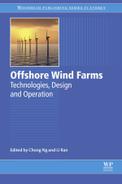10.8. Final remarks
While the initial and natural progression from land to sea called for a simple extension of the tower in the form of an MP configuration, deeper waters, heavier RNAs, and higher hub heights demand the analysis of more complex support systems. The stringent requirement on modal performance can only partially be tackled by more substantial SbSs, and in order to prevent them from becoming prohibitive, towers will need to become more significant. Compared to onshore, offshore tower design faces new technical challenges in the expanded loading scenarios that include actions from the hydrodynamics, sea–ice dynamics, and stress-corrosion. Moreover, while a number of design and certification standards are available, no unified guideline exists. Finally, the biggest challenge still lies within the quest for reduced system LCOE.
The tower engineer must be aware of these formidable challenges that the experience gained on land and that of the O&G industry can only partially overcome. Nonetheless, relaxed transportation constraints, new materials, renewed control strategies, active damping systems, coupled with more powerful computational resources, are new and exciting technical opportunities to achieve a robust and economical design.
This chapter has offered an overview of the loading scenarios and load sources that must be considered when designing an offshore tower, and of the techniques and tools available to calculate the loads. Limit states verification was also presented within the LRFD philosophy following the principal standards of reference and making use of the concepts of reliability and exposure levels. The so-called secondary steel and CPS strategies were also given special attention, as they directly and indirectly affect the distribution of structural steel, and are all but secondary aspects. Simplified design equations were provided notwithstanding emphasis on more rigorous FEA assessments. Focus was on the design of traditional steel tubular towers, with their flanges and shells, as these are still the most common configurations for offshore applications. However, other layouts can be devised following the same principles illustrated herewith, and adding additional detail analyses. For instance, reinforced concrete towers may offer very economical solutions, especially in integrated gravity-based SSts with tall hub heights. Concrete has excellent dynamic (damping) and durability properties, is very versatile in terms of shapes and physical characteristics (strength, stiffness, density), and lends itself to on-site production as well as precast, modular subcomponents. Furthermore, tendon prestress is an efficient way to guarantee overall strength, to connect separate precast rings, and can also be used to fine-tune the tower natural frequencies. All these aspects open up a number of attractive options for the tower designer. Other concepts, such as lattice structures, or a combination of guys and steel/concrete structures can also be envisioned as potential candidates for future installations. In any case, the successful layout will be the one that renders the minimum wind-plant LCOE.
To this end, the tower and the remainder of the components of an OWT ought to be simultaneously designed, and in parallel with considerations for BOS and O&M. Offshore systems appear more tightly coupled than their onshore counterpart. For this reason, single-part optimization will likely yield a suboptimal overall design and a greater LCOE. Multiobjective system optimization should thus be pursued, but it remains a formidable task for several reasons. First, multiple engineering disciplines (eg, geotechnical, civil, mechanical, naval, electrical, and industrial engineering), with their different levels of model fidelity, must be combined to perform accurate analyses; second, the number of parameters and design variables is of daunting proportions. Third, the number of CAE tools that can account for all of these aspects is limited, and even fewer exist that can be easily automated within the optimization process.
In order to achieve this comprehensive view, it is even more important to be able to characterize the system load response as a fully coupled one, simultaneously accounting for aerodynamics, hydrodynamics, structural and control-system dynamics. For instance, the tower (and entire SSt) design can and should take advantage of advanced control devices and techniques. The economical advantages of the so-called co-design, where parametric control configurations can be modeled together with the OWT structural dynamics to arrive at tunable optimum system layouts, should not be overlooked.
As of yet, full optimization is still a non-trivial exercise, with high demand on computational resources and analysis time. Within this context, simplified models are still very valuable and the efficient communication among all the design teams (eg, the WTG OEM and the SSt design firm) is crucial for the success of the wind project. Finally, the role of the experienced designer within each field cannot be overestimated.
Policy and energy challenges will soon demand that offshore wind LCOE be further reduced. Although historically OWT component design has been done sequentially, and within a compartmentalized process, multidisciplinary optimization and system engineering approaches seem indispensable for the offshore industry to flourish in the future.
..................Content has been hidden....................
You can't read the all page of ebook, please click here login for view all page.
